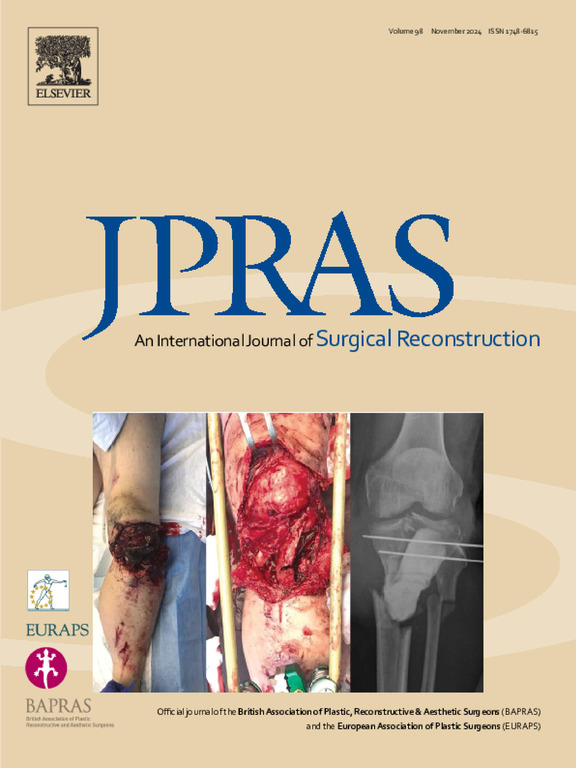Does robotic surgery have a role in abdominal wall reconstruction? A systematic review and meta-analysis
IF 2.4
3区 医学
Q2 SURGERY
Journal of Plastic Reconstructive and Aesthetic Surgery
Pub Date : 2025-05-19
DOI:10.1016/j.bjps.2025.05.009
引用次数: 0
Abstract
Robotic or robotic assisted surgery offers notable advantages in the operating theatre, particularly improved ergonomics and reduced mental and physical workload compared to laparoscopic surgery. This review assessed the feasibility of robotic surgery in abdominal wall reconstruction and hernia repair, as well as the barriers to clinical implementation and training.
Conducted in accordance with preferred reporting items for systematic reviews and meta-analyses guidelines, this systematic review included a literature search of PubMed, Medline, and Embase databases. Descriptive synthesis and mixed fixed/random effects meta-analysis were performed, with unpaired t-tests used for nonparametric data.
A total of 110 clinical and 4 educational articles were reviewed. Robotic surgery was associated with longer operative times than laparoscopic and open approaches, though steep learning curves were commonly reported. However, robotic surgery showed a significantly shorter hospital stay (mean difference: −1.59 days, 95% CI: −1.89 to −1.30) and fewer complications compared to open surgery (OR: 0.75, 95% CI: 0.56–1.01). When compared with laparoscopic surgery, robotic procedures showed a trend towards fewer complications (OR: 0.87, 95% CI: 0.56–1.37).
Although robotic procedures incur higher costs than laparoscopic surgery, the overall cost may be balanced by faster recovery and fewer complications when compared to open surgery.
In conclusion, robotic and robotic assisted surgery are technically feasible and safe for abdominal wall reconstruction. Further high-quality comparative studies, especially against laparoscopic surgery, are needed to justify higher costs and fully evaluate the patient care benefits.
机器人手术在腹壁重建中有作用吗?系统回顾和荟萃分析
与腹腔镜手术相比,机器人或机器人辅助手术在手术室中具有显著的优势,特别是改善了人体工程学,减少了精神和身体工作量。这篇综述评估了机器人手术在腹壁重建和疝修补中的可行性,以及临床实施和培训的障碍。按照系统评价和荟萃分析指南的首选报告项目进行,该系统评价包括PubMed、Medline和Embase数据库的文献检索。进行描述性综合和混合固定/随机效应荟萃分析,对非参数数据使用非配对t检验。我们共回顾了110篇临床论文和4篇教育论文。与腹腔镜和开放式手术相比,机器人手术的手术时间更长,尽管通常报道的学习曲线很陡。然而,与开放手术相比,机器人手术的住院时间明显更短(平均差异:- 1.59天,95% CI: - 1.89至- 1.30),并发症更少(OR: 0.75, 95% CI: 0.56-1.01)。与腹腔镜手术相比,机器人手术的并发症更少(OR: 0.87, 95% CI: 0.56-1.37)。虽然机器人手术比腹腔镜手术成本更高,但与开放手术相比,恢复速度更快,并发症更少,从而平衡了总体成本。总之,机器人和机器人辅助手术在技术上是可行和安全的腹壁重建。需要进一步的高质量的比较研究,特别是针对腹腔镜手术,以证明更高的成本和充分评估患者护理的好处。
本文章由计算机程序翻译,如有差异,请以英文原文为准。
求助全文
约1分钟内获得全文
求助全文
来源期刊
CiteScore
3.10
自引率
11.10%
发文量
578
审稿时长
3.5 months
期刊介绍:
JPRAS An International Journal of Surgical Reconstruction is one of the world''s leading international journals, covering all the reconstructive and aesthetic aspects of plastic surgery.
The journal presents the latest surgical procedures with audit and outcome studies of new and established techniques in plastic surgery including: cleft lip and palate and other heads and neck surgery, hand surgery, lower limb trauma, burns, skin cancer, breast surgery and aesthetic surgery.

 求助内容:
求助内容: 应助结果提醒方式:
应助结果提醒方式:


